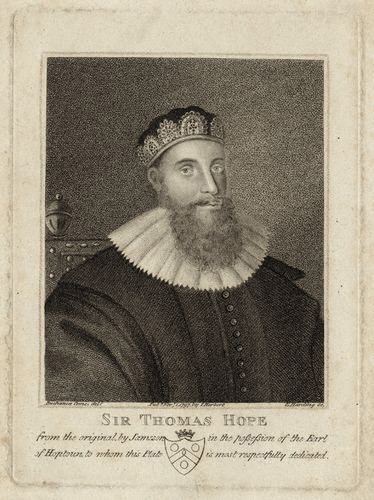Name Sir Hope, | Died 1646 | |
 | ||
Sir Thomas Hope, 1st Baronet Hope of Craighall (1573–1646) was a Scottish lawyer.
Contents
Life
He was the son of an eminent merchant, Henry Hope, and his French wife, Jacqueline de Tott.
Admitted as an advocate in 1605, he made his reputation in 1606 the defence of Rev John Forbes (1568?-1634), and five other ministers at Linlithgow were charged with high treason. He prepared the deed revoking James VI's grants of church property in 1625. He was appointed Lord Advocate under Charles I in 1626, and held the office until 1641. He was created a Baronet of Nova Scotia on 11 February 1628.
Hope conducted the case against John Elphinstone, 2nd Lord Balmerino in 1634. As Lord High Commissioner to the General Assembly of the Church of Scotland in 1643, he maintained the king's temporizing policy.
In 1645 Hope was appointed one of the Commissioners for managing the Exchequer, but died the next year.
He is buried in Greyfriars Kirkyard in Edinburgh. The grave lies in the north-west section of the original graveyard, against the west wall.
His Cowgate home, built in 1616, was demolished in 1887 to make way for the Edinburgh Free Library.
Related Works
His "Practical Observations Upon divers titles of the Law of Scotland", commonly called the "Minor Practicks", were published in 1726, by Alexander Bayne.
In 1843 the Bannatyne Club published "A Diary of the Public Correspondence of Sir Thomas Hope of Craighall, 1633-1645: From the Original, in the Library at Pinkie House"', a collection Hope's official and private correspondence from the last twelve years of his life.
Family
Hope married Elizabeth, daughter of John Binning or Bennet of Wallyford, Haddingtonshire. The couple had the following children:
Of the four sons who survived infancy, three of these reached the bench: John, Thomas and James. Two of these sons were elevated to judges in the Supreme Court.
Two of his sons were appointed to the bench while Hope was Lord Advocate; and it being judged by the Court of Session unbecoming that a father should plead uncovered before his children, the privilege of wearing his hat, while pleading, was granted to him. This privilege his successors in the office of Lord Advocate have in theory ever since enjoyed.
